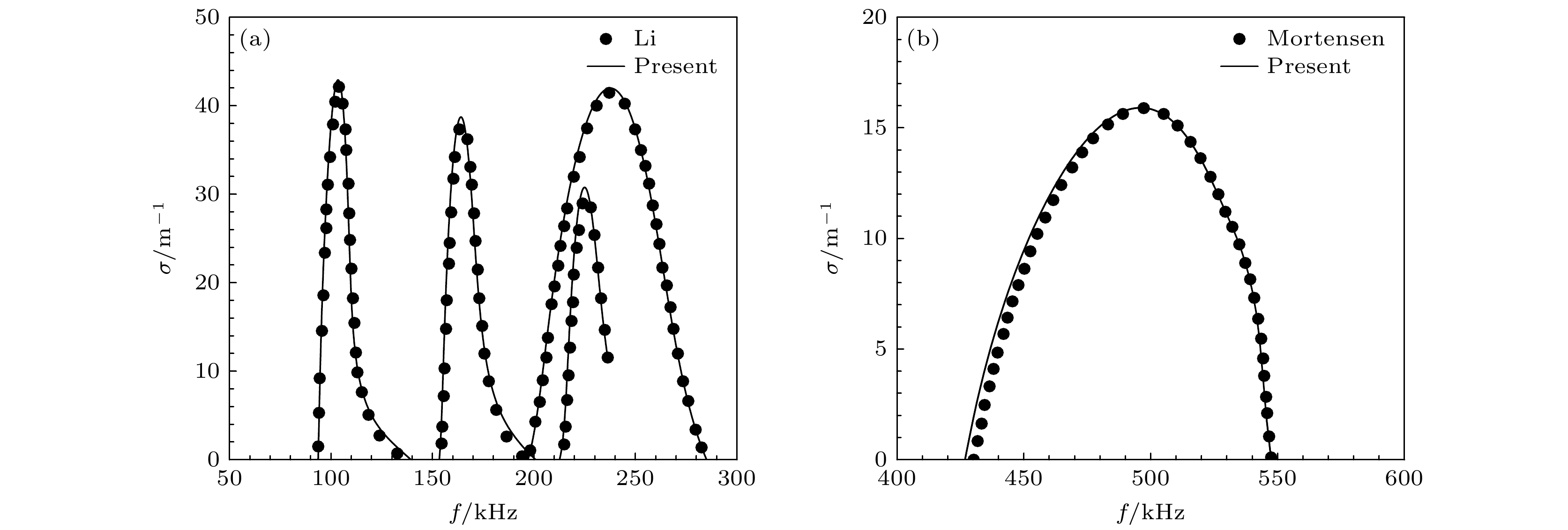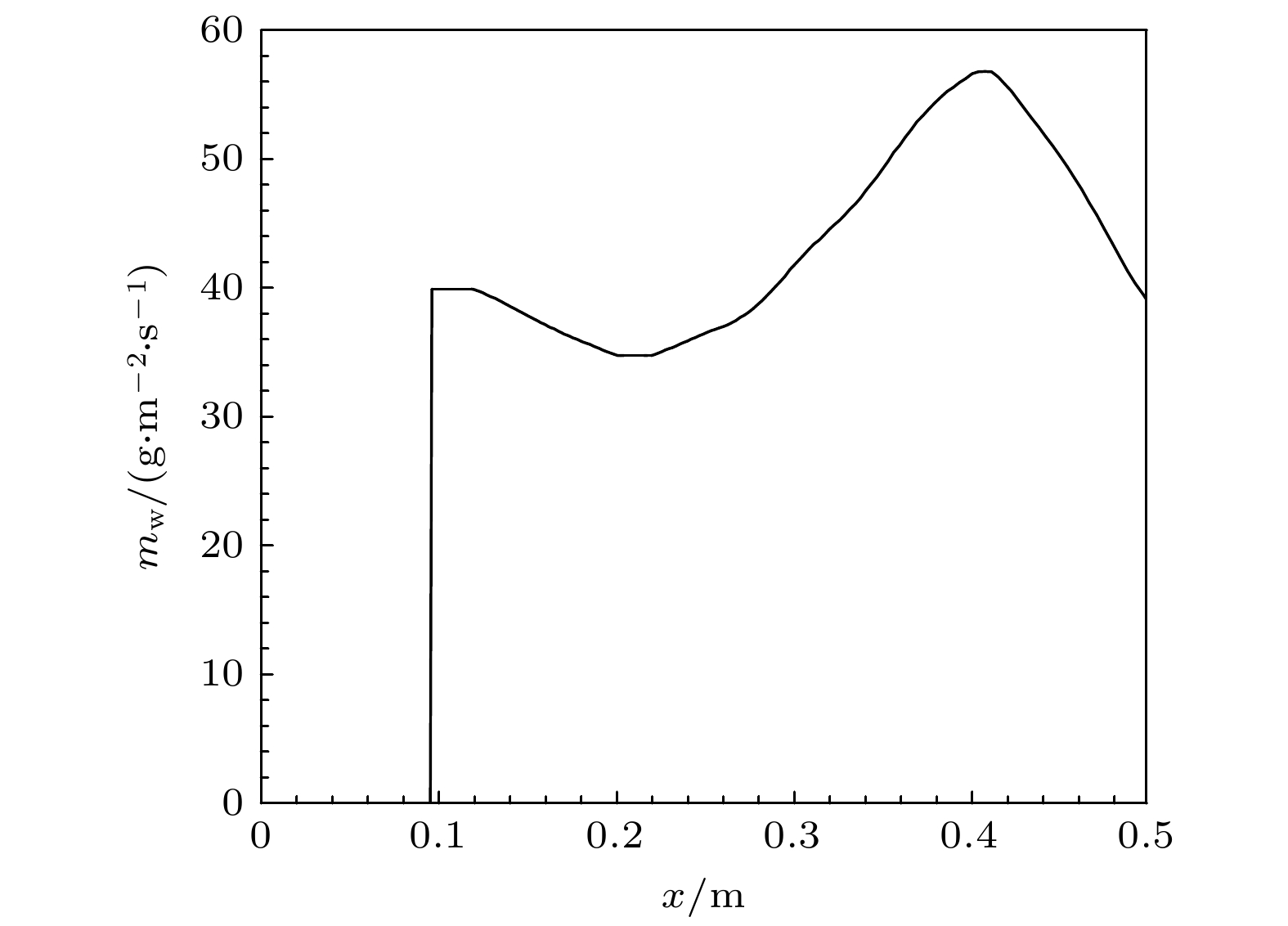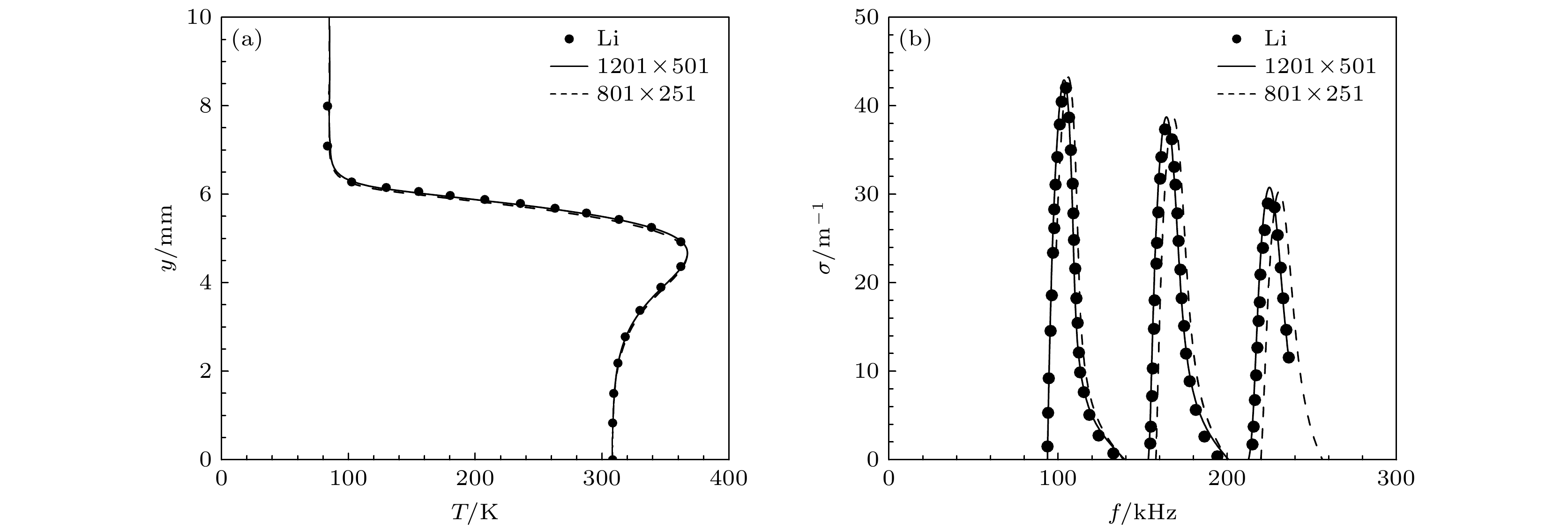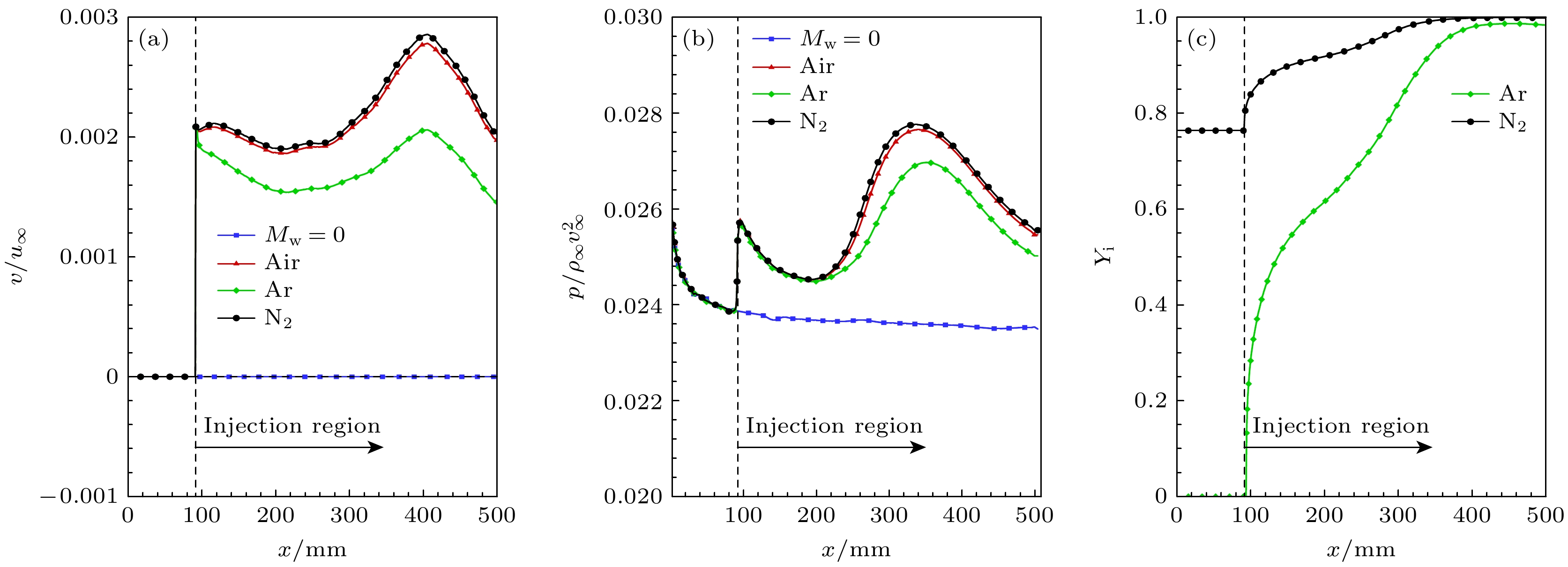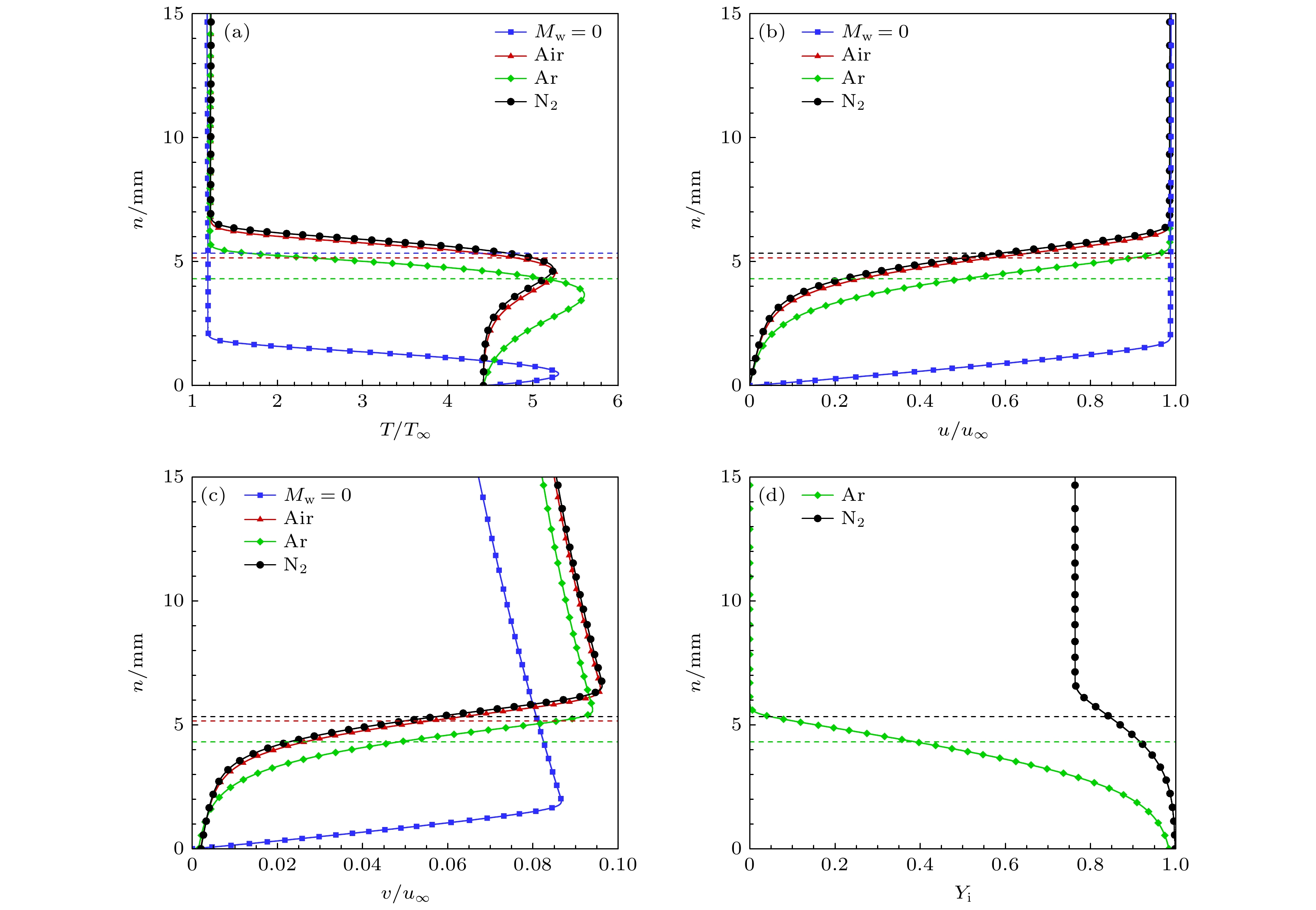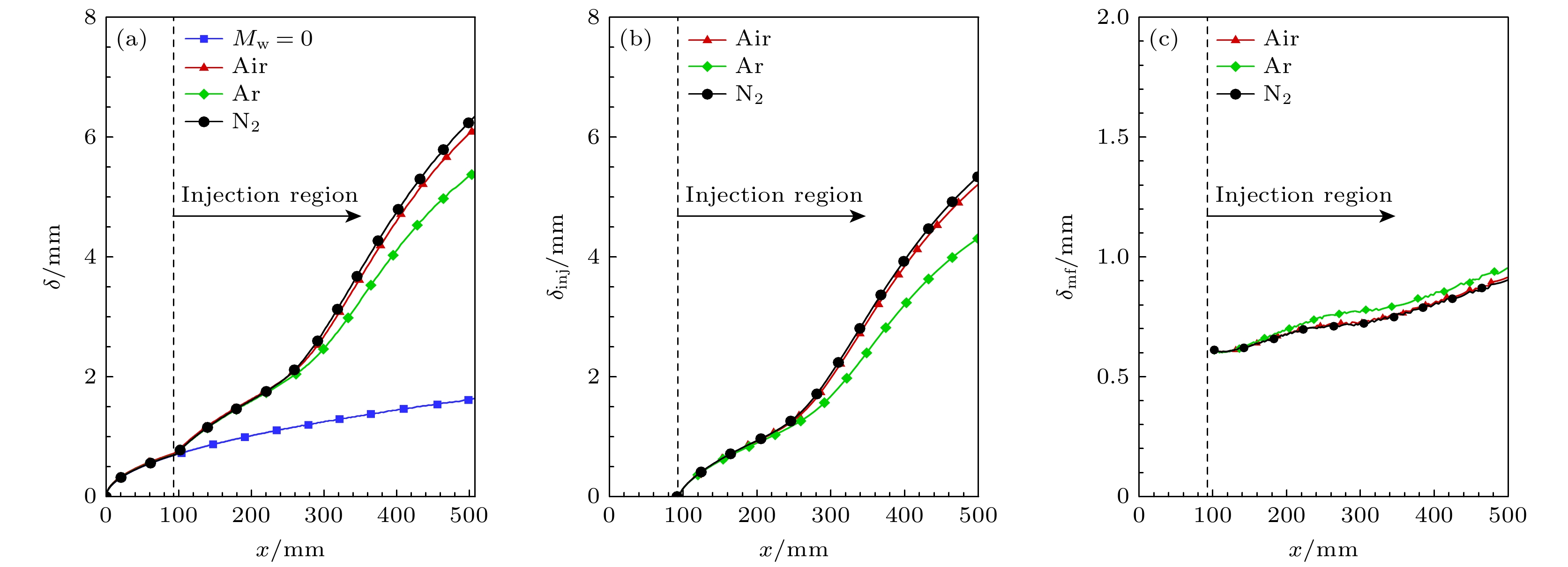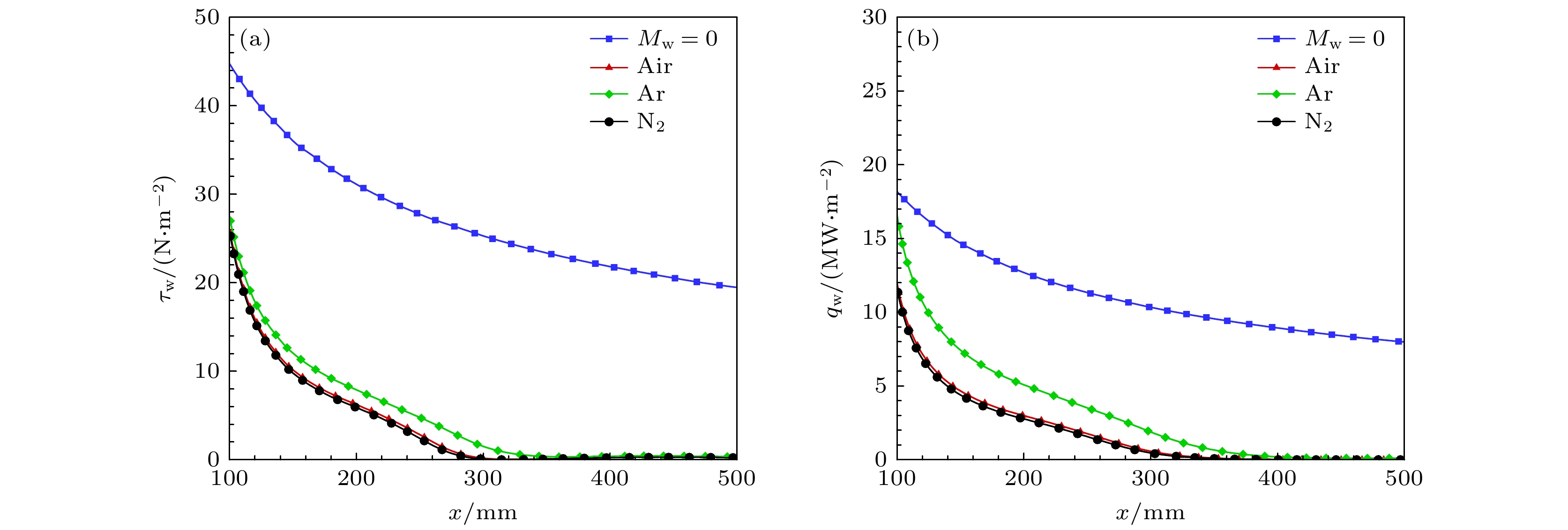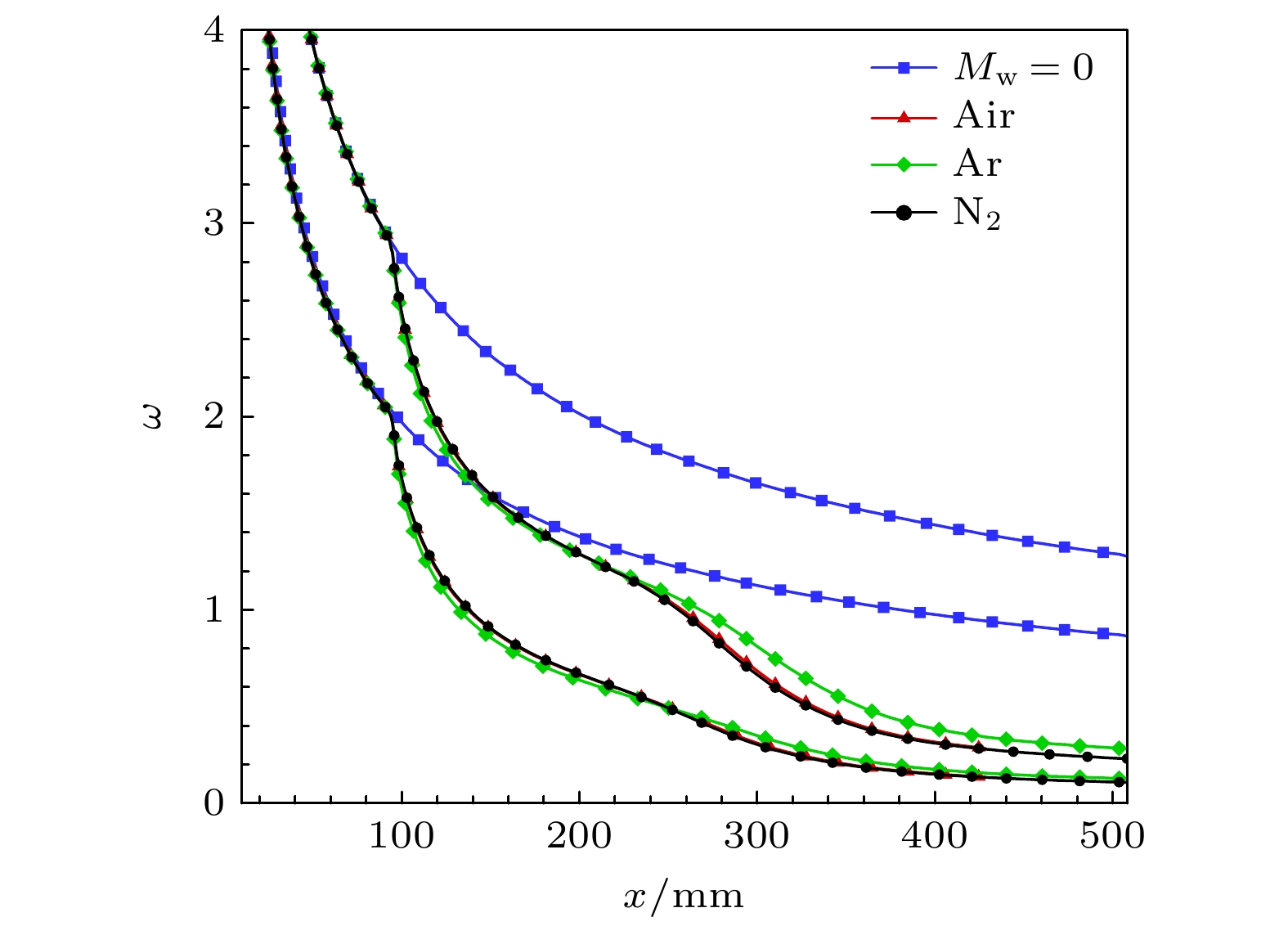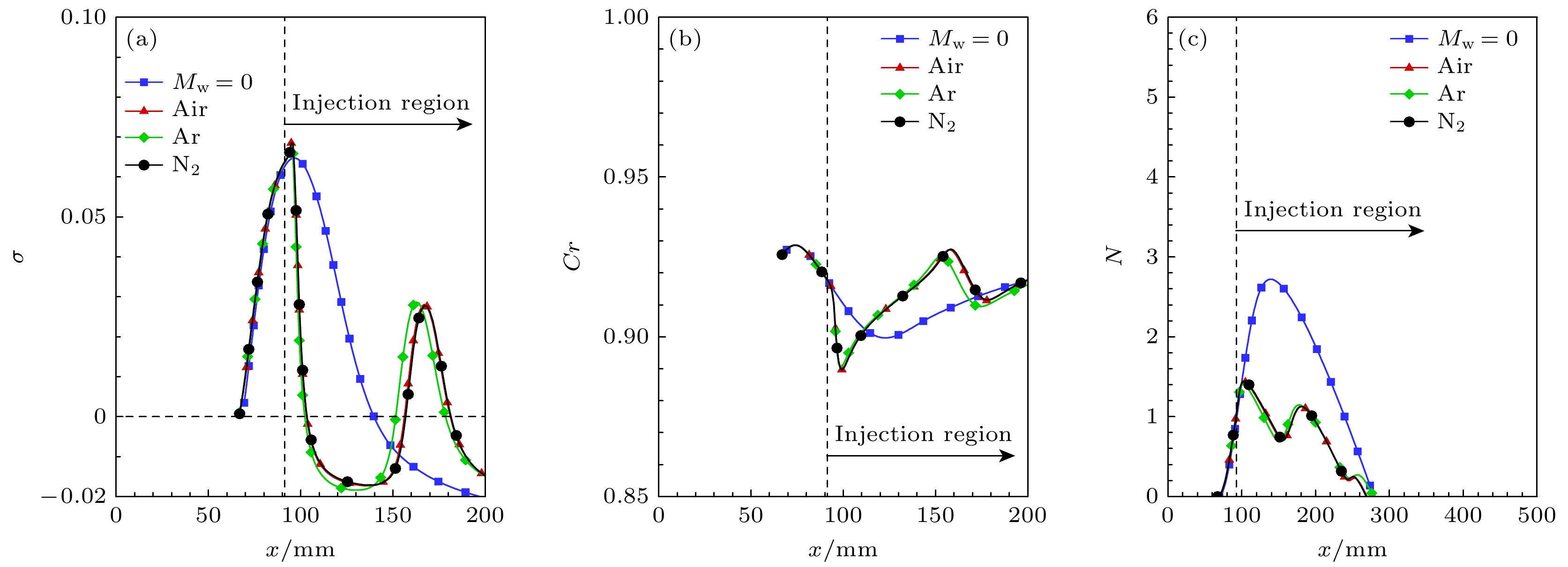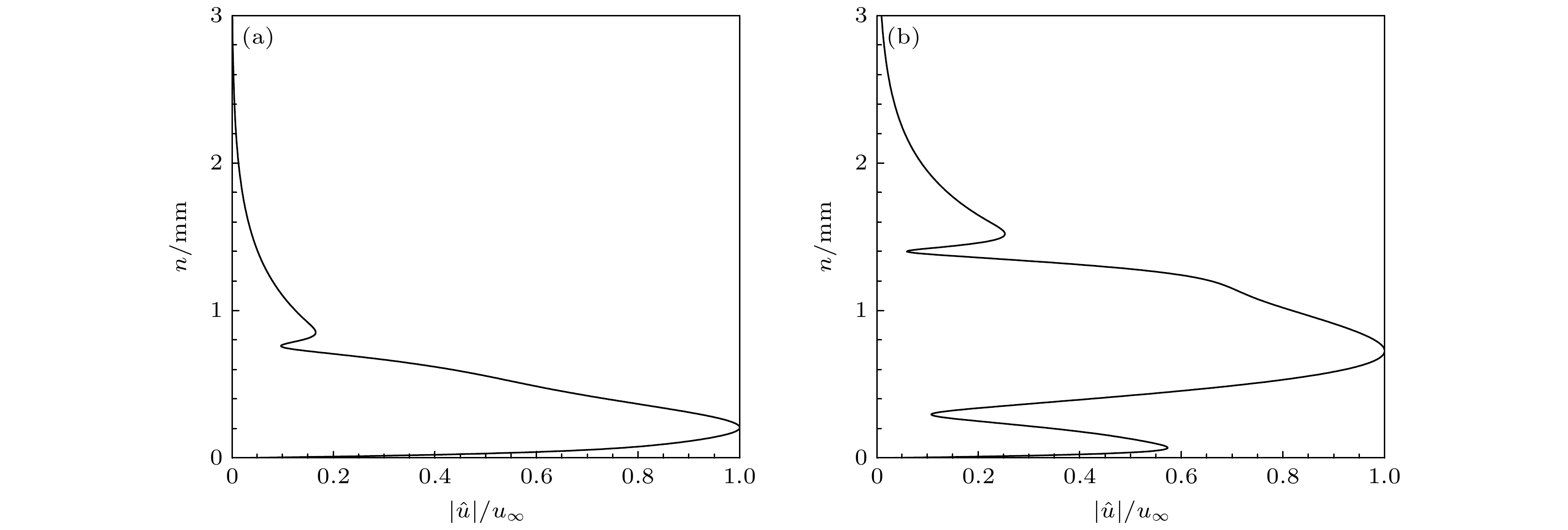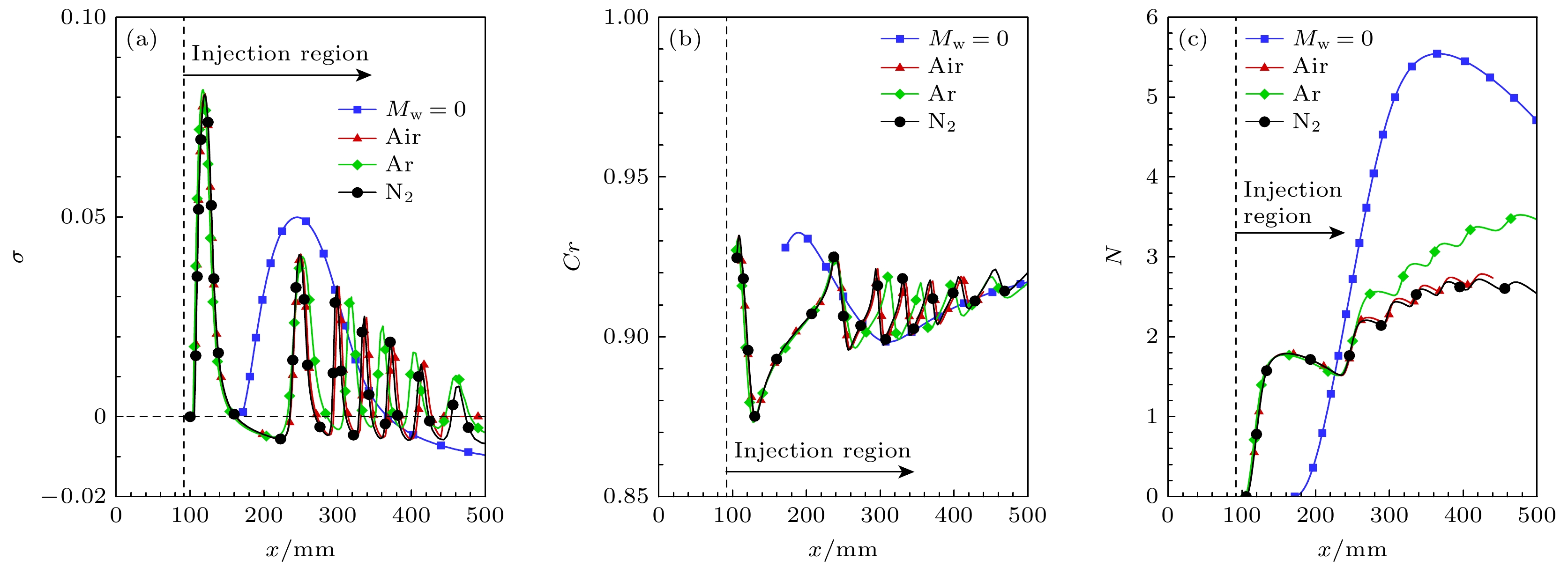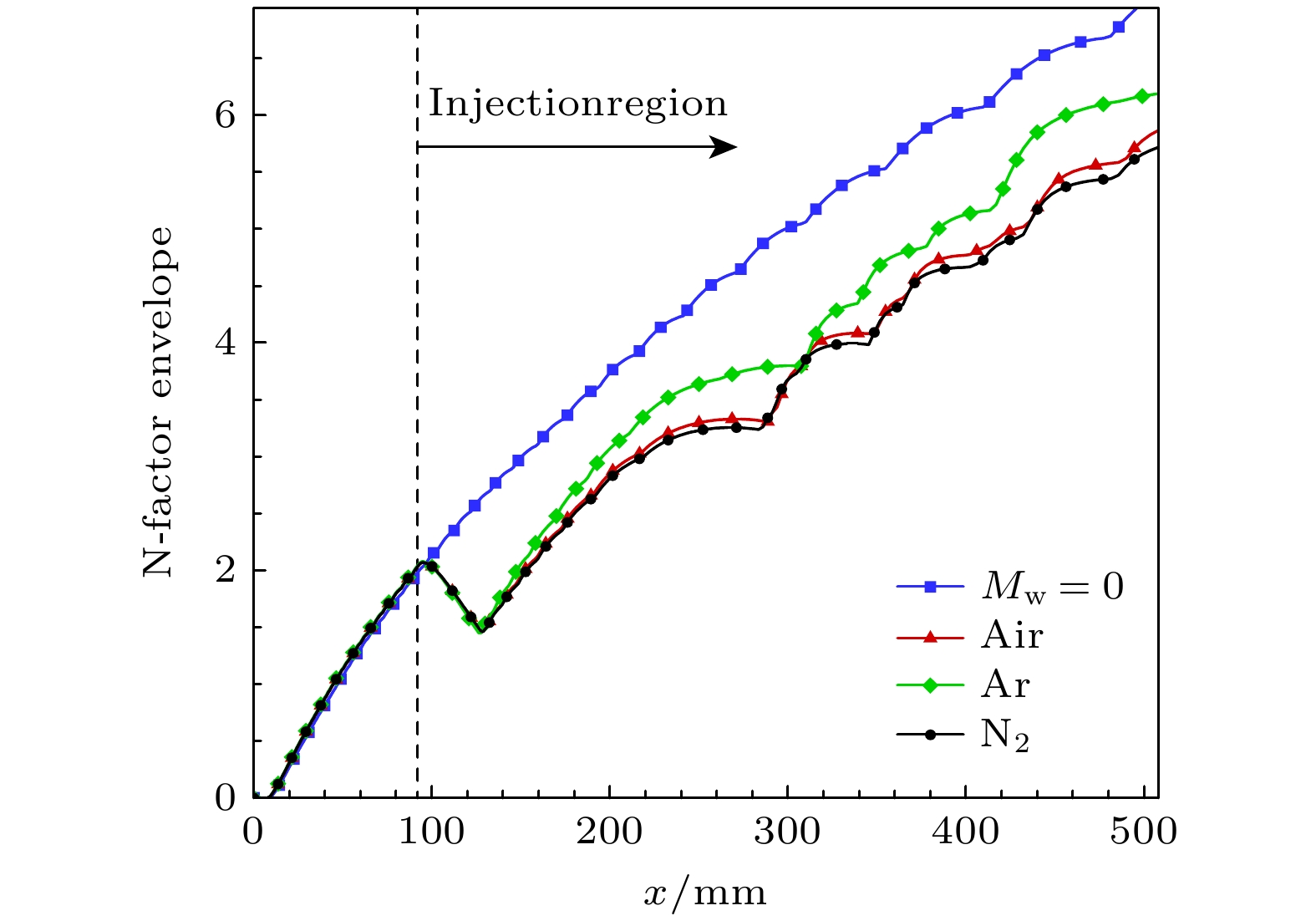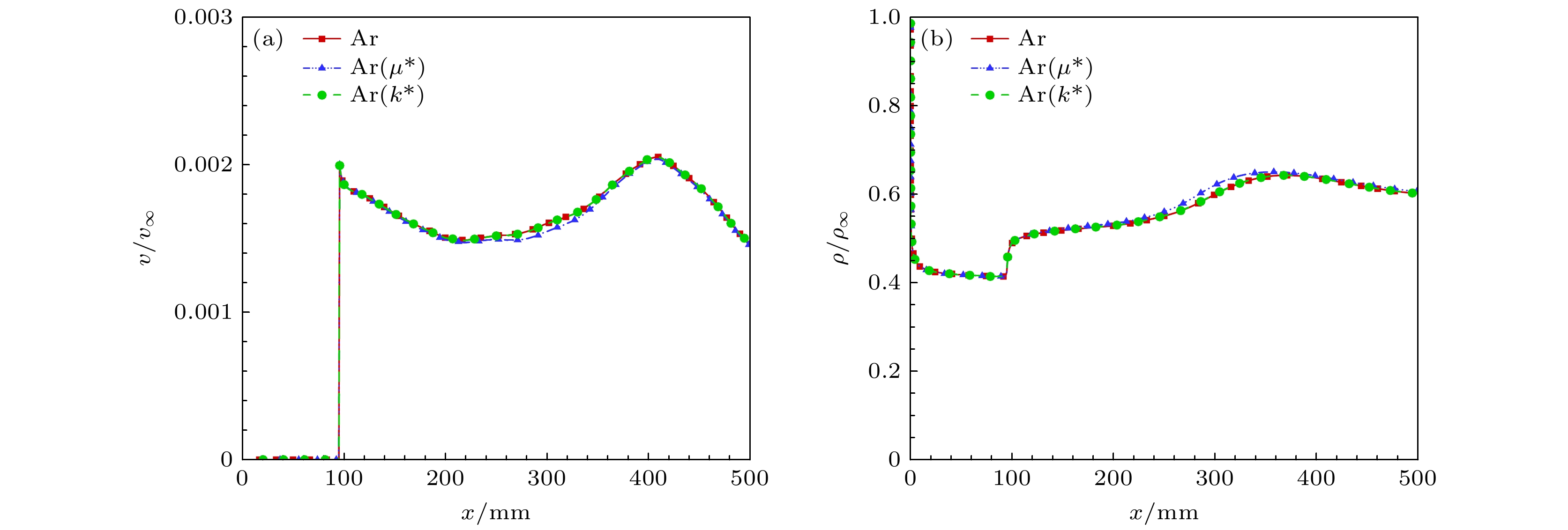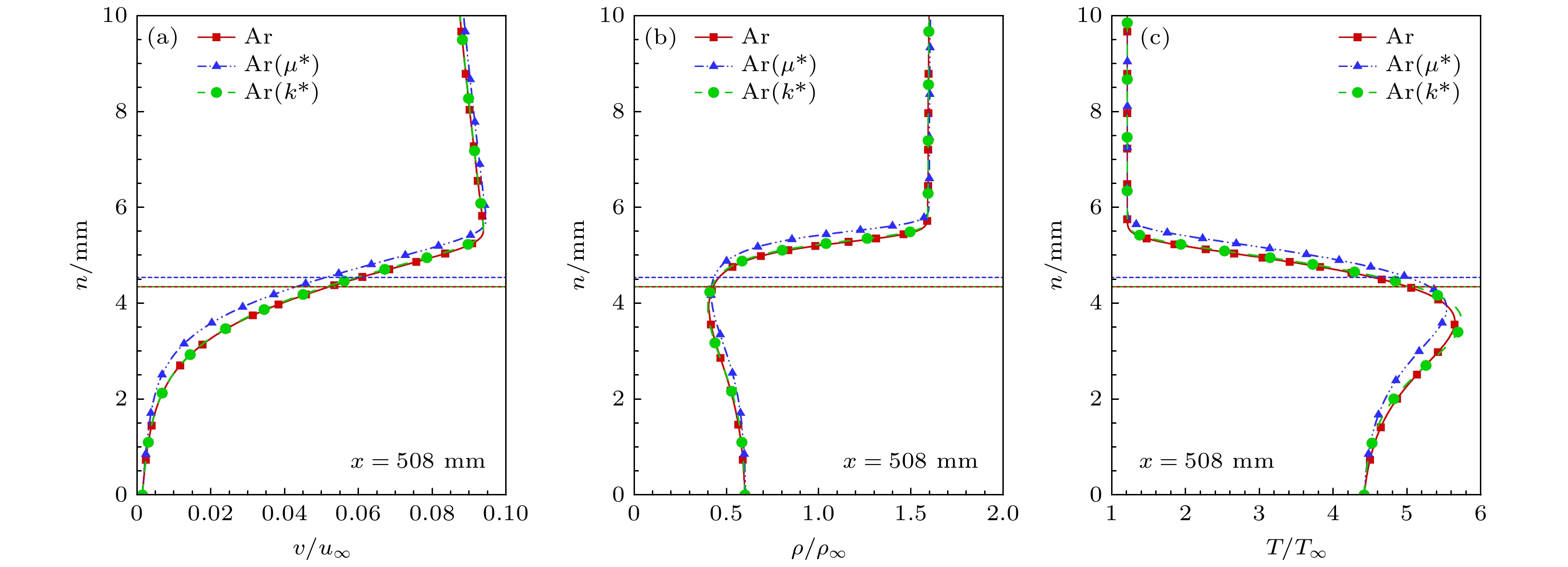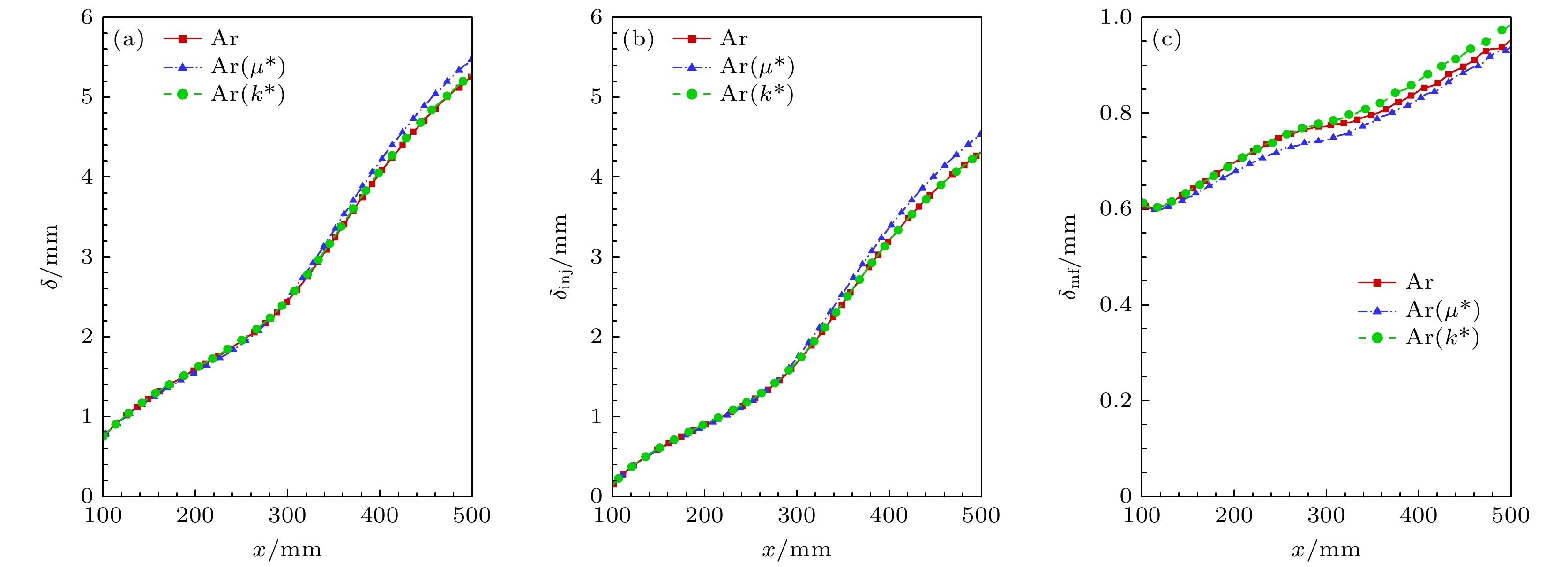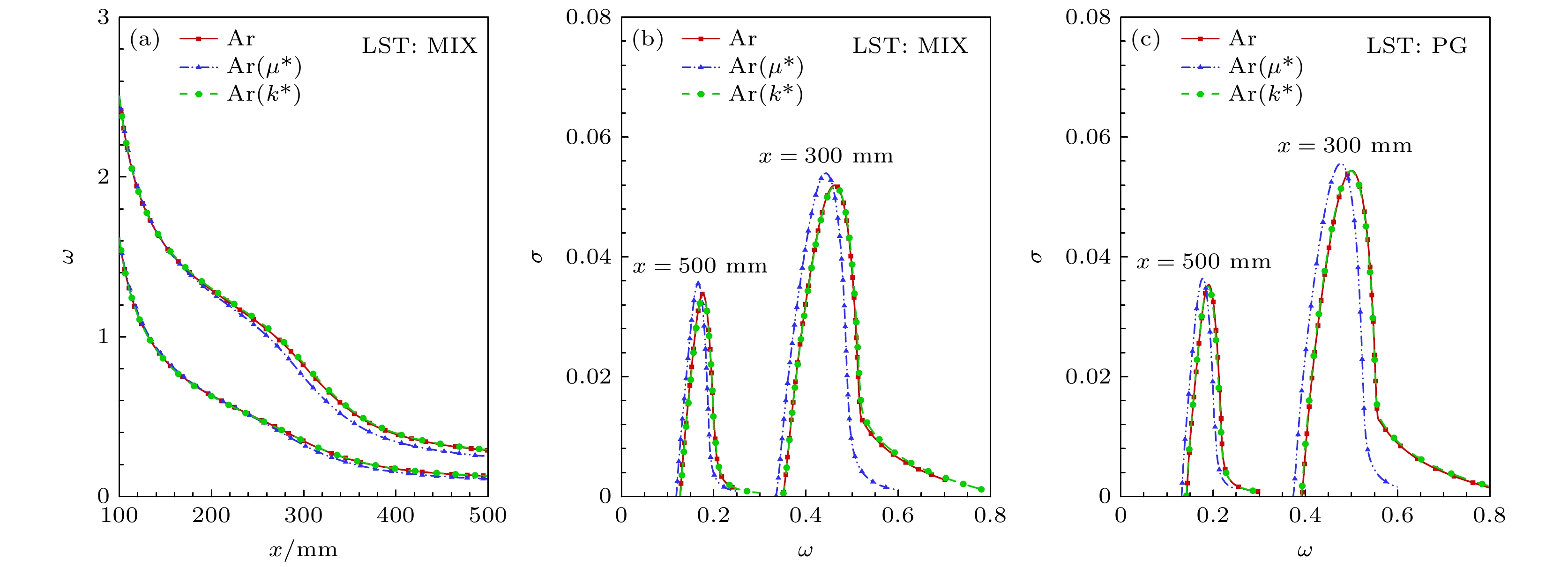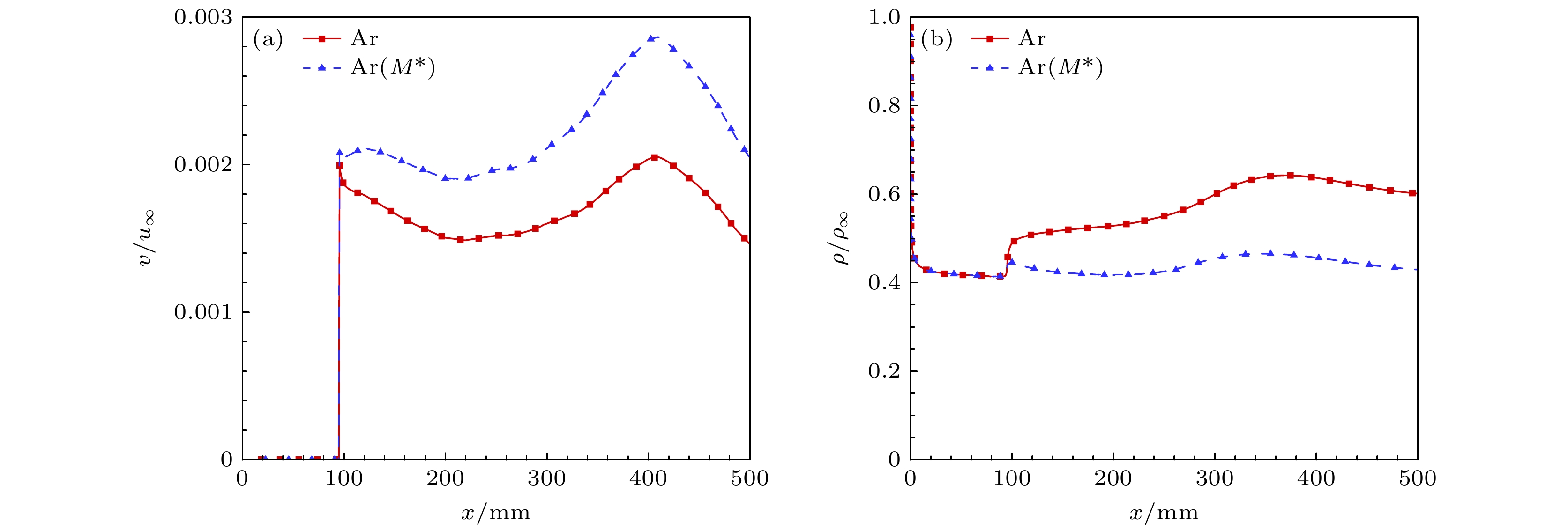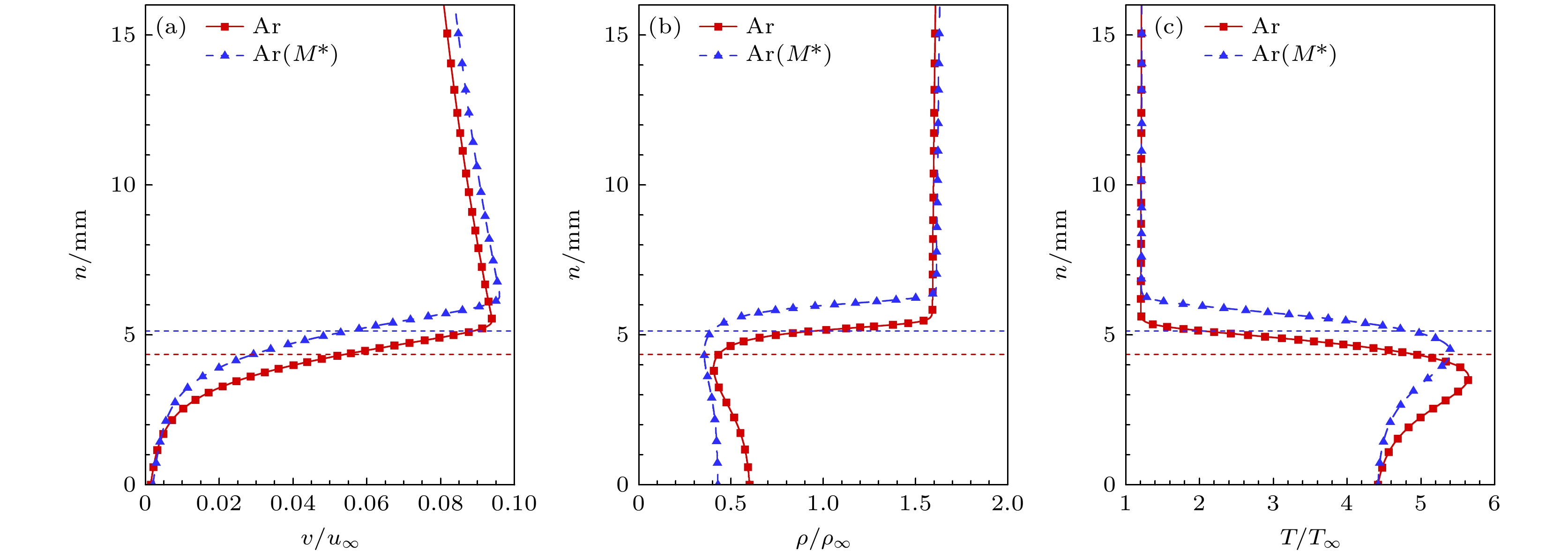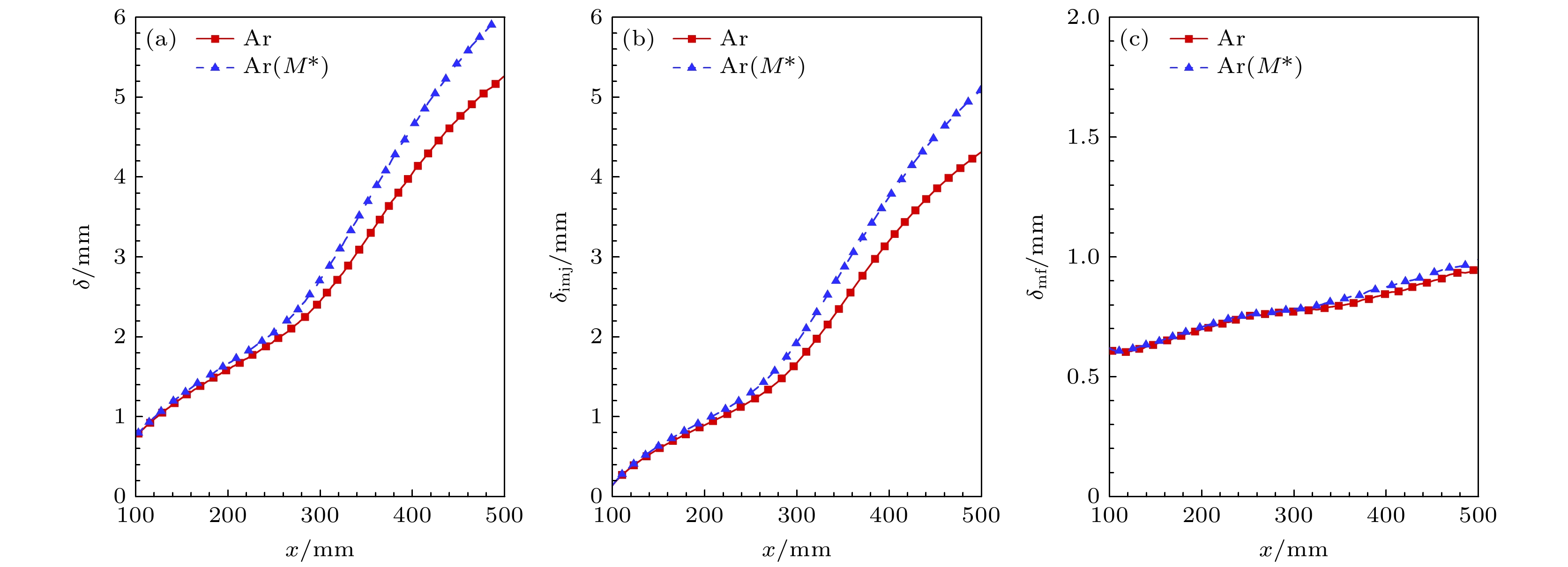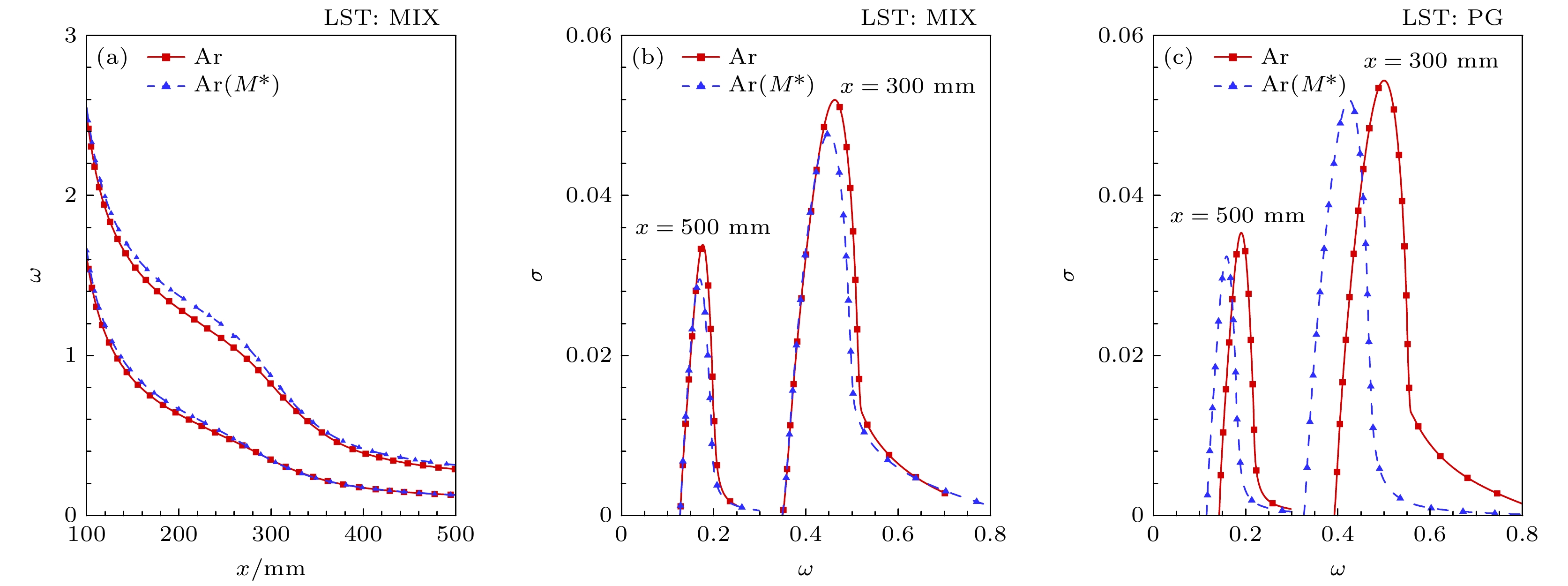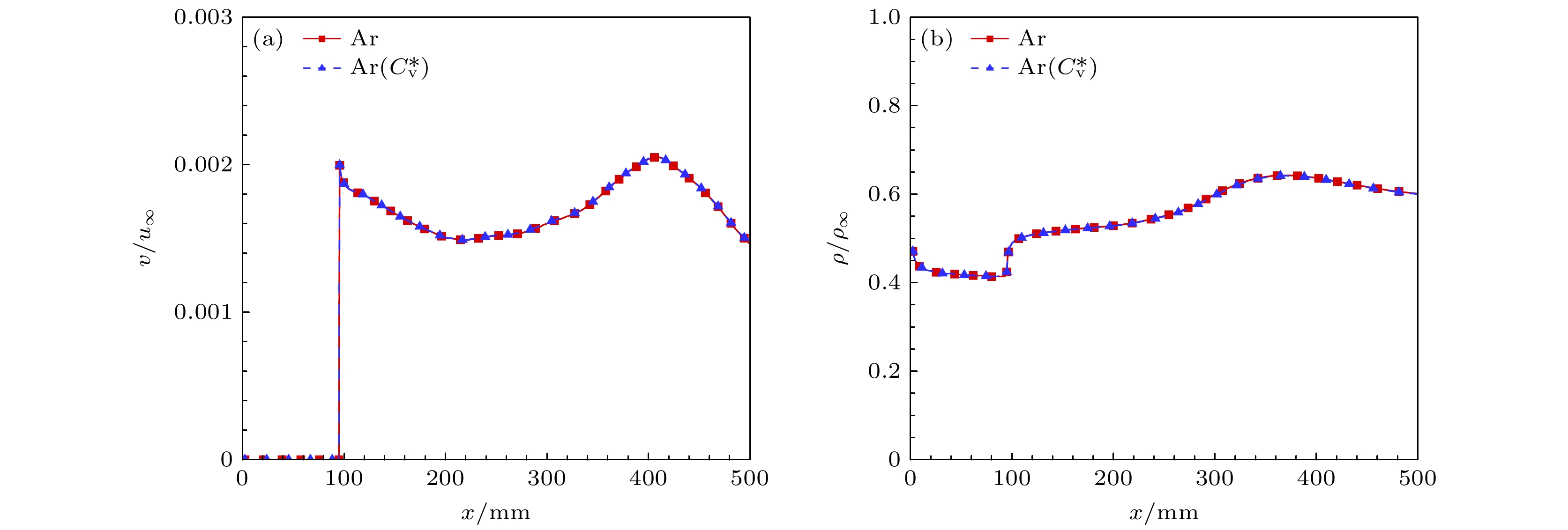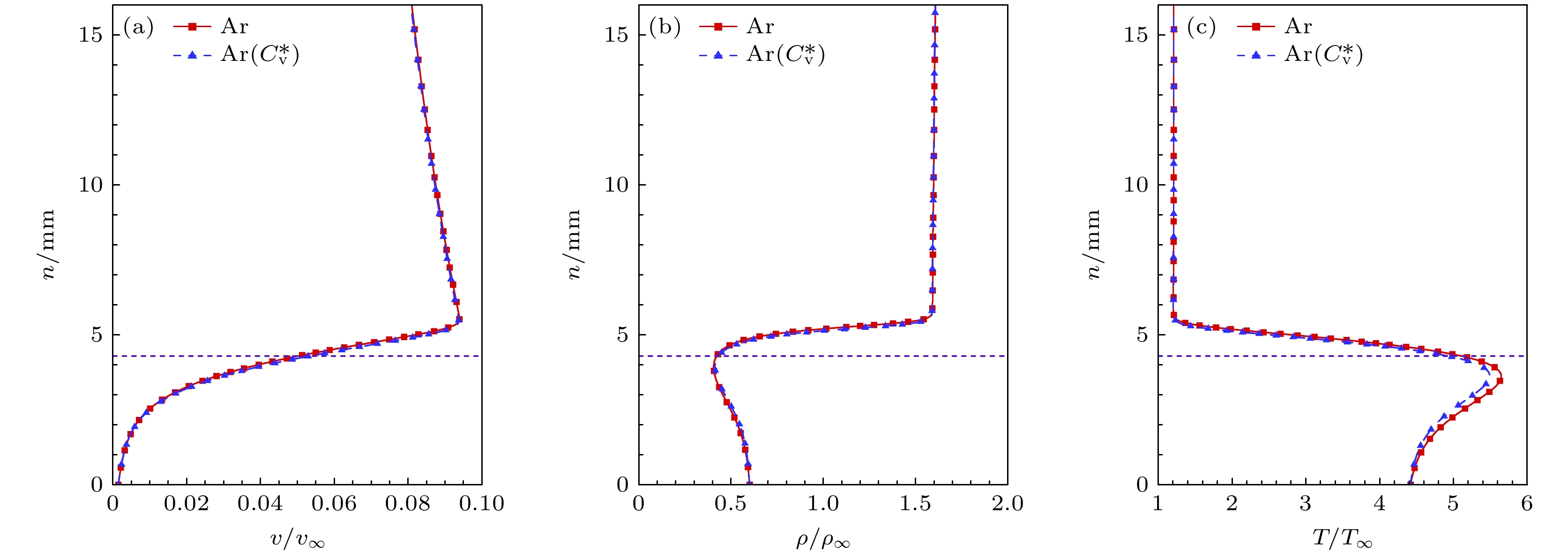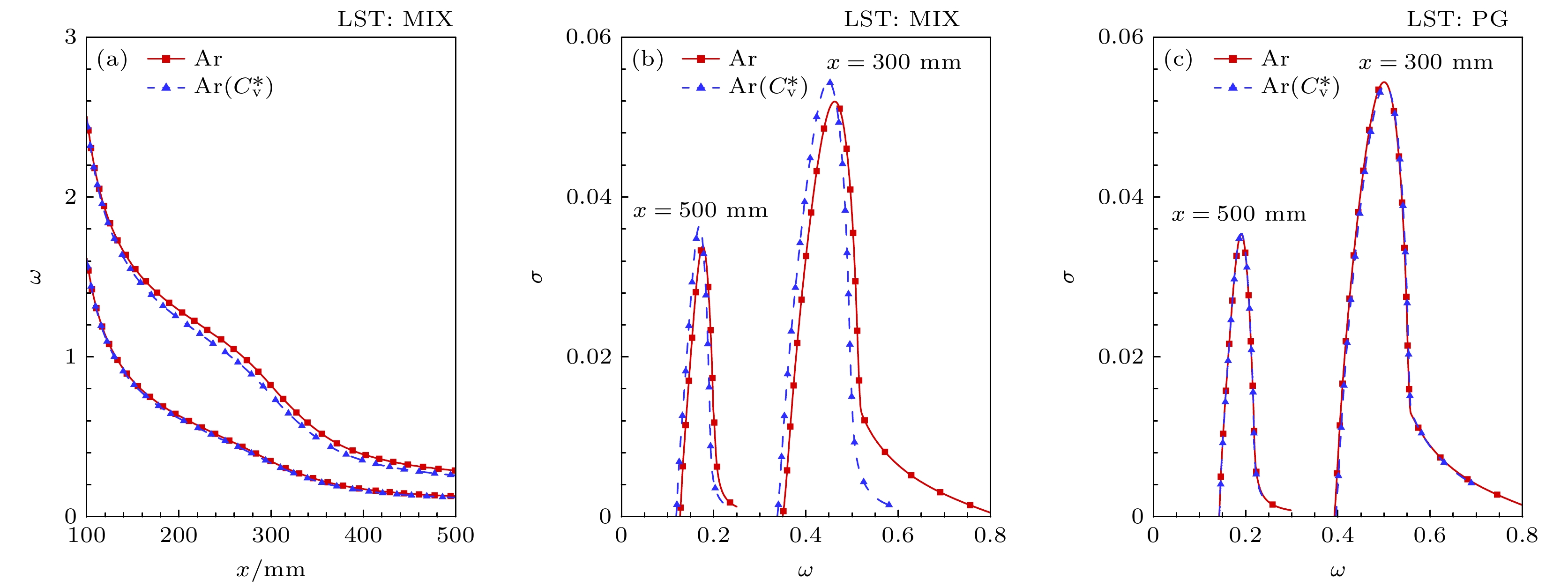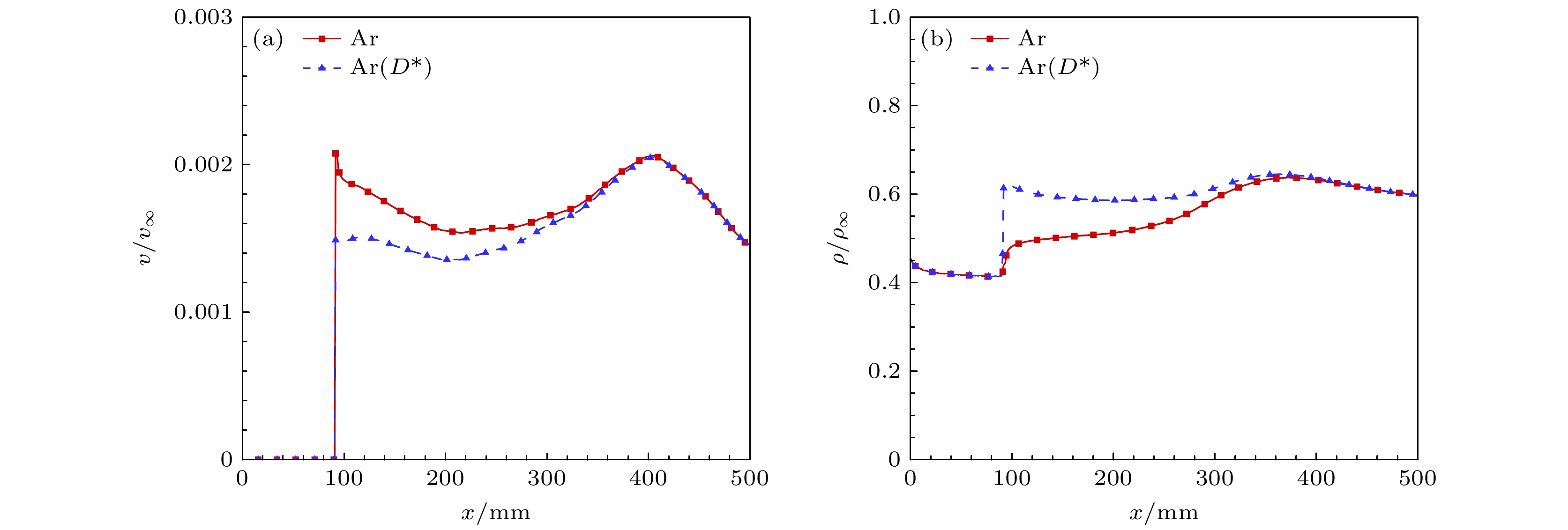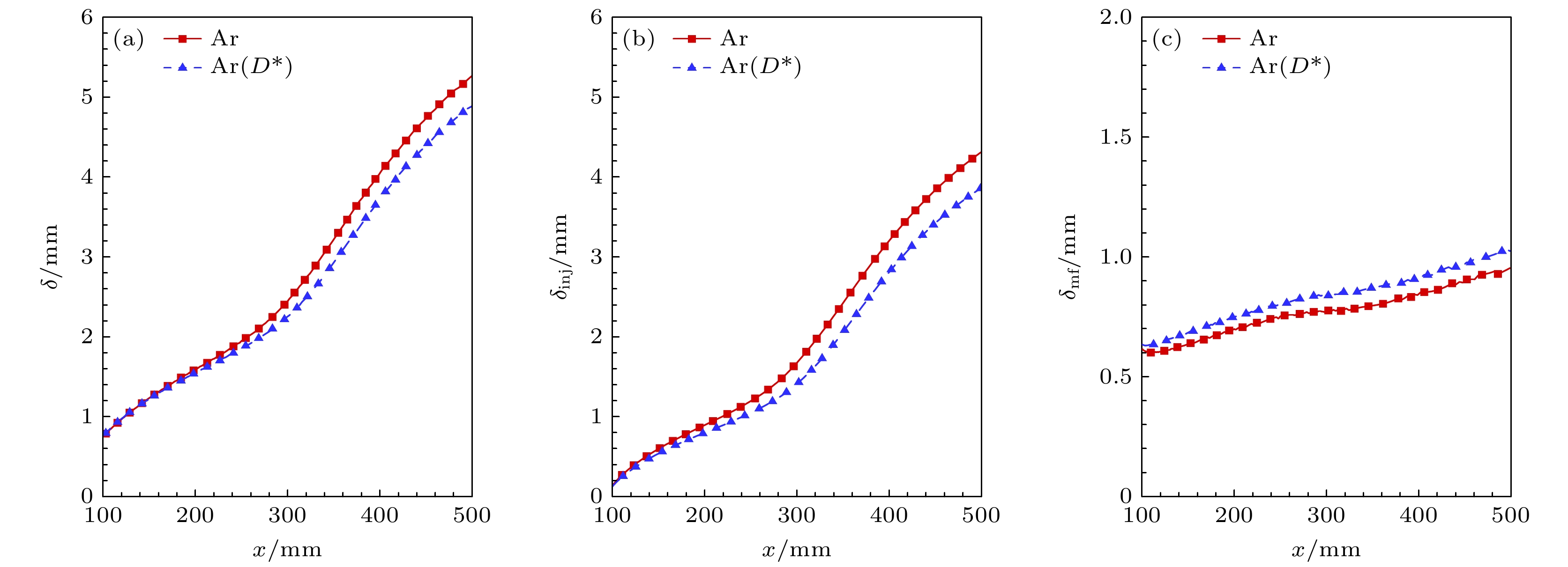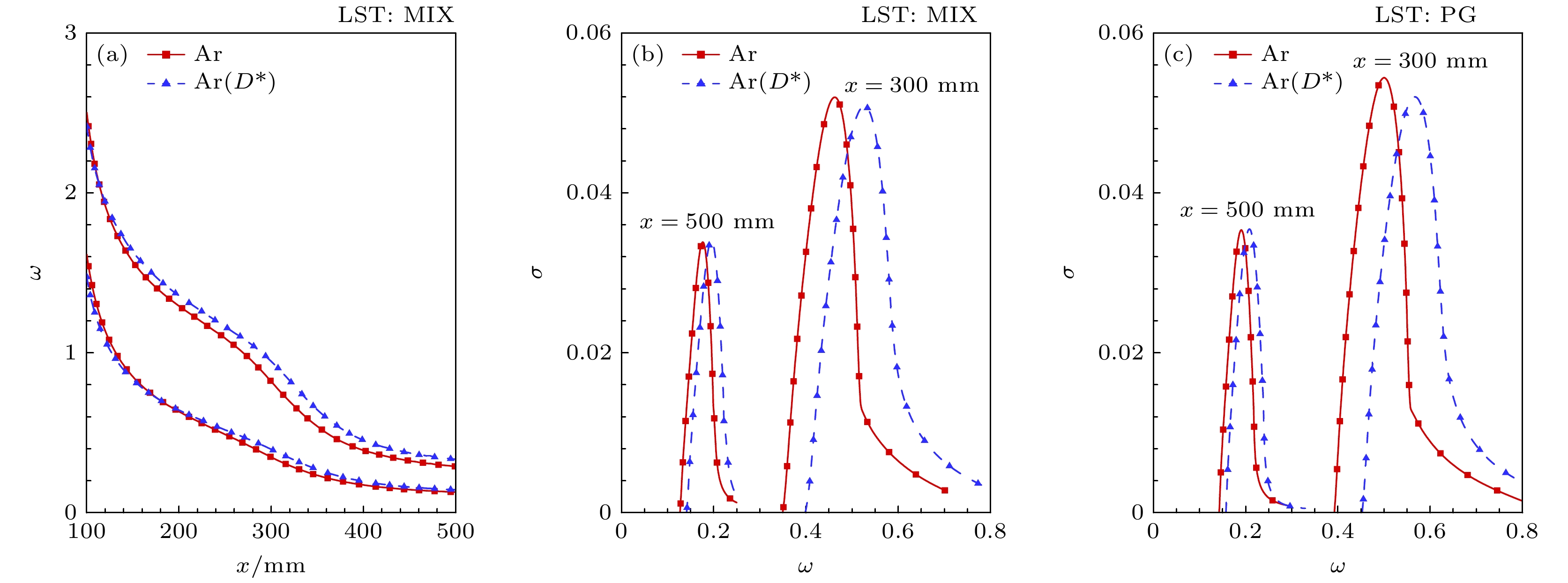-
质量引射会对高超声速边界层稳定性和转捩产生显著影响. 本文采用多组分Navier-Stokes求解器, 计算了不同气体质量引射的流场, 在此基础上分析了质量引射对流动稳定性的影响, 区分了引射气体不同性质的作用. 研究表明, 质量引射排挤主流流体, 形成引射层, 令边界层变厚, 显著降低壁面摩阻和热流. 引射气体的黏性系数、相对分子质量及扩散作用主要影响边界层厚度, 而热传导系数和比热容则主要影响温度分布. 线性稳定性分析结果表明, 质量引射激发多个高阶模态失稳, 但第二模态仍起主导作用, 且质量引射减小第二模态失稳区域, 令扰动积分幅值显著减小, 进而抑制转捩. 引射气体性质的变化通过两条路径影响稳定性: 1)改变基本流剖面; 2)改变混合气体性质. 其中引射气体的输运系数(黏性、扩散)主要通过路径一改变失稳特征, 比热容主要通过路径二起作用, 相对分子质量则通过双路径共同作用.Active mass injection is an effective thermal protection technique that can significantly reduce wall heat flux. However, it inherently changes the stability characteristics of boundary layer, substantially affecting the laminar-to-turbulent transition process. Crucially, the underlying mechanisms of controlling how different injected gases regulate flow stability are still unclear. In order to systematically analyze the effects of different gas injections on flow stability, the gas-specific mass injection effects are investigated in this work by employing a multicomponent Navier-Stokes solver to compute flow fields with air, argon, and nitrogen injections. The influence of mass injection on flow stability is analyzed using linear stability theory, followed by distinguishing the different effects of various injectant properties. The result shows that mass injection can displace the freestream gas, forming an injection layer near the wall and increasing the thickness of the boundary layer. Herein, the properties of the main boundary layer are still similar to those of the original boundary layer, while the injection layer exhibits significantly reduced temperature and velocity gradients, resulting in decrease of wall heat flux and surface friction. Linear stability analysis reveals that when mass injection excites multiple higher-order instability modes, the second mode is still dominant. Notably, mass injection reduces the unstable region of the second mode and significantly lowers the integrated disturbance amplitude, thereby suppressing the transition. This stabilizing effect is more pronounced with lighter gases. The differences in injected gas properties are mainly reflected in the viscosity coefficient, thermal conductivity, relative molecular weight, and diffusivity. Among these, the boundary layer thickness is primarily affected by the viscosity coefficient, relative molecular weight, and diffusivity of the injected gas, while the temperature within the boundary layer decreases with the increase of thermal conductivity and specific heat capacity of the injected gas. The influence of injected gas properties on flow stability is manifested in two different ways: 1) Modification of basic flow profile and 2) change of mixed gas properties. Specifically, the transport coefficients (viscosity and diffusivity) of the injected gas mainly affect unstable characteristics through way 1), while the specific heat capacity mainly works through way 2). The relative molecular weight plays a combined role in the two ways.
-
Keywords:
- mass injection /
- linear stability theory /
- hypersonic boundary layer
[1] 朱广生, 姚世勇, 段毅 2023 航空学报 44 529049
Zhu G S, Yao S Y, Duan Y 2023 Acta Aeronaut. Astronaut. Sin. 44 529049
[2] 温景浩, 李晨辉, 涂国华, 万兵兵, 段茂昌, 张锐 2025 物理学报 74 124701
 Google Scholar
Google Scholar
Wen J H, Li C H, Tu G H, Wan B B, Duan M C, Zhang R 2025 Acta Phys. Sin. 74 124701
 Google Scholar
Google Scholar
[3] 沈斌贤, 曾磊, 刘骁, 周述光, 葛强 2022 空气动力学报学报 40 1
Shen X B, Zeng L, Liu X, Zhou S G, Ge Q 2022 Acta Aerodyn. Sin. 40 1
[4] 樊宇翔, 赵瑞, 左政玄, 阳光, 李宁 2023 航空学报 44 528587
Fan Y X, Zhao R, Zuo Z X, Yang G, Li N 2023 Acta Aeronaut. Astronaut. Sin. 44 528587
[5] 叶友达 2015 科学通报 60 1095
Ye Y D 2015 Sci. Bull. 60 1095
[6] 赵一朴 2022 博士学位论文 (北京: 北京交通大学)
Zhao Y P 2022 Ph. D. Dissertation (Beijing: Beijing Jiaotong University
[7] Pappas C C, Okuno A F 1960 J. Aerosp. Sci. 27 321
[8] Marvin J G, Akin C M 1970 AIAA J. 8 857
 Google Scholar
Google Scholar
[9] Wang X, Zhong X, Ma Y 2011 AIAA J. 49 1336
 Google Scholar
Google Scholar
[10] 赵耕夫 1994 力学学报 26 631
Zhao G F 1994 Chin. J. Theor. Appl. Mech. 26 631
[11] 赵耕夫 1999 空气动力学学报 17 21
Zhao G F 1999 Acta Aerodyn. Sin. 17 21
[12] Johnson H B, Gronvall J E, Candler G V 2009 47th AIAA Aerospace Sciences Meeting including The New Horizons Forum and Aerospace Exposition Orlando, Florida, January 5, 2009 p938
[13] Ghaffari S, Marxen O, Gianluca I, Eric S G 2010 48th AIAA Aerospace Sciences Meeting Including the New Horizons Forum and Aerospace Exposition Orlando, Florida, January 4, 2010 p706
[14] 李瑾, 苏伟, 黄章峰, 刘文伶 2020 航空动力学报 35 280
Li J, Su W, Huang Z F, Liu W L 2020 J. Aerosp. Power 35 280
[15] Kumar C, Prakash A 2022 Phys. Fluids 34 064109
 Google Scholar
Google Scholar
[16] Li F, Choudhari M, Chang C, White J 2013 Phys. Fluids 25 104107
 Google Scholar
Google Scholar
[17] Wagnild R M, Candler G V, Leyva L A, Jewell J S, Hornung H G 2010 48th AIAA Aerospace Sciences Meeting Including the New Horizons Forum and Aerospace Exposition Orlando, Florida, January 4, 2010 p1244
[18] Lysenko V I, Gaponov S A, Smorodsky B V, Yermolaev Y G, Kosinov A D, Semionov N V 2016 J. Fluid Mech. 798 751
 Google Scholar
Google Scholar
[19] Lysenko V I, Smorodsky B V, Ermolaev Y G, Kosinov A D 2018 Thermophys. Aeromech. 25 183
 Google Scholar
Google Scholar
[20] Gaponov S A, Smorodsky B V 2016 Int. J. Theor. Appl. Mech. 1 97
[21] Gaponov S A, Smorodsky B V 2017 AIP Conference Proceedings. Novosibirsk, Russia, 1893 030087
[22] Miró Miró F, Pinna F 2018 Phys. Fluids 30 084106
 Google Scholar
Google Scholar
[23] Miró Miró F, Pinna F 2020 J. Fluid Mech. 890 R4
 Google Scholar
Google Scholar
[24] Han L B, Han Y F 2024 Phys. Fluids 36 036110
 Google Scholar
Google Scholar
[25] 苏彩虹 周恒 2009 中国科学(G辑) 39 123
Su C H, Zhou H 2009 Sci. China Ser. G 39 123
[26] 罗纪生 2015 航空学报 36 357
Luo J S 2015 Acta Aeronaut. Astronaut. Sin. 36 357
[27] 苏彩虹 2008 博士学位论文 (天津: 天津大学)
Su C H 2008 Ph. D. Dissertation (Tianjin: Tianjin University
[28] Mortensen C H 2015 Ph. D. Dissertation (Los Angeles: University of California
[29] Miró Miró F, Dehairs P, Pinna F, Gkolia M, Masutti D, Regert T, Chazot O 2019 AIAA J. 57 1567
 Google Scholar
Google Scholar
[30] Fedorov A, Tumin A 2011 AIAA J. 49 1647
 Google Scholar
Google Scholar
-
图 9 不同气体质量引射的边界层厚度 (a) 边界层厚度$ \delta $; (b) 引射层厚度$ {\delta _{ {\text{inj}}}} $; (c) 主流边界层厚度$ {\delta _{ {\text{mf}}}} $对比
Fig. 9. Comparison under different injection conditions: (a) Boundary layer thickness $ \delta $; (b) injection layer thickness $ {\delta _{ {\text{inj}}}} $; (c) mainstream boundary layer thickness $ {\delta _{ {\text{mf}}}} $.
图 18 引射气体的黏性系数、热传导系数对基本流的影响 (a) 边界层厚度$ \delta $; (b) 引射层厚度$ {\delta _{{\text{inj}}}} $; (c) 主流边界层厚度$ {\delta _{{\text{mf}}}} $
Fig. 18. Effect of viscosity and thermal conductivity of the injected gas on the base flow: (a) Boundary layer thickness $ \delta $; (b) injection layer thickness $ {\delta _{{\text{inj}}}} $; (c) mainstream boundary layer thickness $ {\delta _{{\text{mf}}}} $.
图 19 引射气体的黏性系数、热传导系数对流动稳定性的影响 (a) 中性曲线对比; (b) 混合气体模型下不同流向位置的增长率随频率变化; (c) 完全气体模型下不同流向位置的增长率随频率变化
Fig. 19. Effect of viscosity and thermal conductivity of the injected gas on flow stability: (a) Comparison of neutral curves; (b) variation of growth rate with frequency at different streamwise positions under the mixed gas model; (c) variation of growth rate with frequency at different streamwise positions under the perfect gas model.
图 22 引射气体的相对分子质量对基本流的影响 (a) 边界层厚度$ \delta $; (b) 引射层厚度$ {\delta _{ {\text{inj}}}} $; (c) 主流边界层厚度$ {\delta _{ {\text{mf}}}} $
Fig. 22. Effect of the relative molecular mass of the injected gas on the flow stability: (a) Boundary layer thickness $ \delta $; (b) injection layer thickness $ {\delta _{ {\text{inj}}}} $; (c) mainstream boundary layer thickness $ {\delta _{ {\text{mf}}}} $.
图 23 引射气体的相对分子质量对流动稳定性的影响 (a) 中性曲线对比; (b) 混合气体模型下不同流向位置的增长率随频率变化; (c) 完全气体模型下不同流向位置的增长率随频率变化
Fig. 23. Effect of the relative molecular mass of the injected gas on flow stability: (a) Comparison of neutral curves; (b) variation of growth rate with frequency at different streamwise positions under the mixed gas model; (c) variation of growth rate with frequency at different streamwise positions under the perfect gas model.
图 26 引射气体的比热容对流动稳定性的影响 (a) 中性曲线对比; (b) 混合气体模型下不同流向位置的增长率随频率变化; (c) 完全气体模型下不同流向位置的增长率随频率变化
Fig. 26. Effect of the specific heat capacity of the injected gas on flow stability: (a) Comparison of neutral curves; (b) variation of growth rate with frequency at different streamwise positions under the mixed gas model; (c) variation of growth rate with frequency at different streamwise positions under the perfect gas model.
图 29 引射气体的扩散作用对基本流的影响 (a) 边界层厚度$ \delta $; (b) 引射层厚度$ {\delta _{{\text{inj}}}} $; (c)主流边界层厚度$ {\delta _{{\text{mf}}}} $
Fig. 29. Effect of the diffusion of the injected gas on the base flow: (a) Boundary layer thickness $ \delta $; (b) injection layer thickness $ {\delta _{{\text{inj}}}} $; (c) mainstream boundary layer thickness $ {\delta _{{\text{mf}}}} $.
图 30 引射气体的扩散作用对流动稳定性的影响 (a) 中性曲线对比; (b) 混合气体模型下不同流向位置的增长率随频率变化; (c) 完全气体模型下不同流向位置的增长率随频率变化
Fig. 30. Effect of the diffusion of the injected gas on flow stability: (a) Comparison of neutral curves; (b) variation of growth rate with frequency at different streamwise positions under the mixed gas model; (c) variation of growth rate with frequency at different streamwise positions under the perfect gas model.
i $ {\mu _{{\text{ref}}i}} $/(kg·m–1·s–1) $ {S_{\mu i}} $/K $ {T_{{\text{ref}}i}} $/K Ar 2.117×10–5 146.3 273.16 N2 1.656×10–5 104.7 273.16 O2 1.919×10–5 125 273.16 表 2 引射气体性质
Table 2. Properties of the injected gas.
引射气体 黏性系数 热传导系数 相对分子质量 比热容 扩散作用 Ar 不变 不变 40 $ \dfrac{3}{2}{R_{{\text{Ar}}}} $ 不变 Ar(μ*) $ \mu $下降, $ {\mu _{{\text{Ar}}\left( {\mu^*} \right)}} = {\mu _{{{\text{N}}_{2}}}} = 1.656 \times {10^{ - 5}}{\left(\dfrac{T}{{273.16}}\right)^{3/2}}\left(\dfrac{{273.16 + 104.7}}{{T + 104.7}}\right) $ Ar(k*) $ k $下降, $ {\kappa _{{\text{Ar}}\left( {k^*} \right)}} = {\kappa _{{{\text{N}}_{2}}}} = 1.656 \times {10^{ - 5}}{\left(\dfrac{T}{{273.16}}\right)^{3/2}}\left(\dfrac{{273.16 + 104.7}}{{T + 104.7}}\right)\left(\dfrac{5}{2}c_{{\text{v, tra}}}^{{\text{Ar}}} + c_{{\text{v, tor}}}^{{\text{Ar}}}\right) $ Ar(M*) $ M $下降, $ {M_{{\text{Ar}}\left( {M^*} \right)}} = {M_{{{\text{N}}_{2}}}} = {28} $ Ar($C_{\rm v}^*$) $ C_{\text{v}} $上升, $ C_{\text{v},\text{Ar}\left( {C_{\text{v}}^*} \right)}= C_{\text{v},\text{N}_{2}} = \dfrac{5}{2}{R_{{\text{Ar}}}} $ Ar(D*) $ {D_{{\text{Ar}}\left( {D^*} \right)}} \to {0} $ 表 3 气体性质对流动稳定性的作用路径
Table 3. The pathway of gas properties on flow stability.
作用路径 主要影响
因素对第二模态影响 改变
边界层
剖面相对分子
质量相对分子质量增大, 边界层厚度降低,
不稳定频率增大、最大增长率增大黏性系数 黏性系数增大, 边界层厚度降低,
不稳定频率增大、最大增长率降低扩散 扩散作用导致边界层厚度增大,
不稳定频率降低改变混
合气体
性质相对分子
质量相对分子质量增大, 不稳定频率降低 比热容 比热容增大, 不稳定频率降低、
最大增长率增大 -
[1] 朱广生, 姚世勇, 段毅 2023 航空学报 44 529049
Zhu G S, Yao S Y, Duan Y 2023 Acta Aeronaut. Astronaut. Sin. 44 529049
[2] 温景浩, 李晨辉, 涂国华, 万兵兵, 段茂昌, 张锐 2025 物理学报 74 124701
 Google Scholar
Google Scholar
Wen J H, Li C H, Tu G H, Wan B B, Duan M C, Zhang R 2025 Acta Phys. Sin. 74 124701
 Google Scholar
Google Scholar
[3] 沈斌贤, 曾磊, 刘骁, 周述光, 葛强 2022 空气动力学报学报 40 1
Shen X B, Zeng L, Liu X, Zhou S G, Ge Q 2022 Acta Aerodyn. Sin. 40 1
[4] 樊宇翔, 赵瑞, 左政玄, 阳光, 李宁 2023 航空学报 44 528587
Fan Y X, Zhao R, Zuo Z X, Yang G, Li N 2023 Acta Aeronaut. Astronaut. Sin. 44 528587
[5] 叶友达 2015 科学通报 60 1095
Ye Y D 2015 Sci. Bull. 60 1095
[6] 赵一朴 2022 博士学位论文 (北京: 北京交通大学)
Zhao Y P 2022 Ph. D. Dissertation (Beijing: Beijing Jiaotong University
[7] Pappas C C, Okuno A F 1960 J. Aerosp. Sci. 27 321
[8] Marvin J G, Akin C M 1970 AIAA J. 8 857
 Google Scholar
Google Scholar
[9] Wang X, Zhong X, Ma Y 2011 AIAA J. 49 1336
 Google Scholar
Google Scholar
[10] 赵耕夫 1994 力学学报 26 631
Zhao G F 1994 Chin. J. Theor. Appl. Mech. 26 631
[11] 赵耕夫 1999 空气动力学学报 17 21
Zhao G F 1999 Acta Aerodyn. Sin. 17 21
[12] Johnson H B, Gronvall J E, Candler G V 2009 47th AIAA Aerospace Sciences Meeting including The New Horizons Forum and Aerospace Exposition Orlando, Florida, January 5, 2009 p938
[13] Ghaffari S, Marxen O, Gianluca I, Eric S G 2010 48th AIAA Aerospace Sciences Meeting Including the New Horizons Forum and Aerospace Exposition Orlando, Florida, January 4, 2010 p706
[14] 李瑾, 苏伟, 黄章峰, 刘文伶 2020 航空动力学报 35 280
Li J, Su W, Huang Z F, Liu W L 2020 J. Aerosp. Power 35 280
[15] Kumar C, Prakash A 2022 Phys. Fluids 34 064109
 Google Scholar
Google Scholar
[16] Li F, Choudhari M, Chang C, White J 2013 Phys. Fluids 25 104107
 Google Scholar
Google Scholar
[17] Wagnild R M, Candler G V, Leyva L A, Jewell J S, Hornung H G 2010 48th AIAA Aerospace Sciences Meeting Including the New Horizons Forum and Aerospace Exposition Orlando, Florida, January 4, 2010 p1244
[18] Lysenko V I, Gaponov S A, Smorodsky B V, Yermolaev Y G, Kosinov A D, Semionov N V 2016 J. Fluid Mech. 798 751
 Google Scholar
Google Scholar
[19] Lysenko V I, Smorodsky B V, Ermolaev Y G, Kosinov A D 2018 Thermophys. Aeromech. 25 183
 Google Scholar
Google Scholar
[20] Gaponov S A, Smorodsky B V 2016 Int. J. Theor. Appl. Mech. 1 97
[21] Gaponov S A, Smorodsky B V 2017 AIP Conference Proceedings. Novosibirsk, Russia, 1893 030087
[22] Miró Miró F, Pinna F 2018 Phys. Fluids 30 084106
 Google Scholar
Google Scholar
[23] Miró Miró F, Pinna F 2020 J. Fluid Mech. 890 R4
 Google Scholar
Google Scholar
[24] Han L B, Han Y F 2024 Phys. Fluids 36 036110
 Google Scholar
Google Scholar
[25] 苏彩虹 周恒 2009 中国科学(G辑) 39 123
Su C H, Zhou H 2009 Sci. China Ser. G 39 123
[26] 罗纪生 2015 航空学报 36 357
Luo J S 2015 Acta Aeronaut. Astronaut. Sin. 36 357
[27] 苏彩虹 2008 博士学位论文 (天津: 天津大学)
Su C H 2008 Ph. D. Dissertation (Tianjin: Tianjin University
[28] Mortensen C H 2015 Ph. D. Dissertation (Los Angeles: University of California
[29] Miró Miró F, Dehairs P, Pinna F, Gkolia M, Masutti D, Regert T, Chazot O 2019 AIAA J. 57 1567
 Google Scholar
Google Scholar
[30] Fedorov A, Tumin A 2011 AIAA J. 49 1647
 Google Scholar
Google Scholar
计量
- 文章访问数: 2235
- PDF下载量: 33
- 被引次数: 0













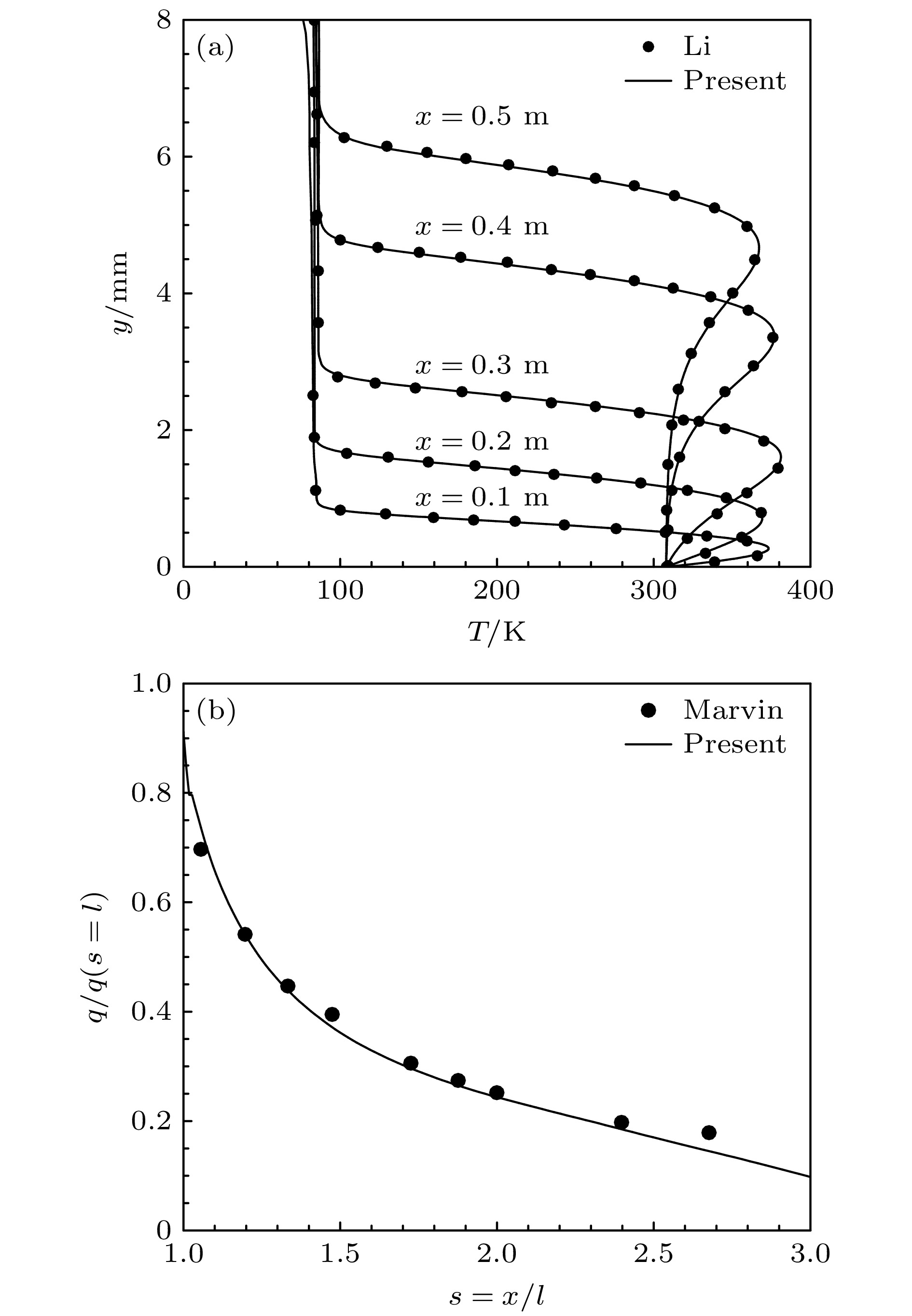
 下载:
下载:
